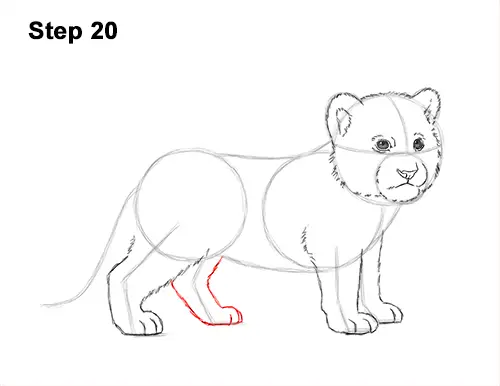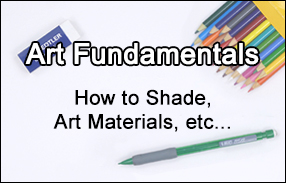
Step 20: Use the last line under the body as a guide to draw the other hind leg. Draw the leg around the guide and only darken the lines when you get the shape right. The top of this leg will be hidden behind the other hind leg and body. Don't forget the paws at the bottom!

Step 21: Use the remaining lines and shapes as guides to draw the rest of the tiger cub's body. Simply darken the outer edges of the initial guides to create the shape of the body. Use short strokes on the underside of the body and chest for the fur. Use the curved line on the left as a guide to draw the tiger's tail. Just like with the legs, lightly sketch the tail around the guide. When you get the shape right, darken the lines.

Step 22: For a cleaner look, erase as much as you can of the initial guide lines. Don't worry about erasing all of the guides. It's okay to leave some behind. Re-draw any final sketch lines on your tiger cub that you may have accidentally erased.

Final Step: Use a dark value to add the tiger stripe pattern all over the body starting with the forehead. Draw a few spots right above the eyes and short, horizontal stripes higher along the head. Leave the area around the eyes blank. Draw longer, curved, vertical stripes on the sides of the head. Don't draw the stripes as a single shape and then shade them in. Draw the stripes using short strokes that simulate fur. Darken the sides of the mouth. Add some thin stripes on the sides of the nose for the base of the tiger cub's whiskers. For a more detailed guide on how to shade, check out this tutorial: How to shade.
Draw the tiger cub's stripes along the rest of the body but leave the chest and paws blank. The stripes on the body should be vertical, while the stripes on the legs and tail should be horizontal. Remember to use short, dark strokes to create the shape of the stripes for a fur-like texture.
Add a light value to the rest of the tiger cub's body. Make sure that this value is lighter than the stripes. Vary the pressure on your pencil to get different degrees of tonal value. Leave the ears, the cheeks, the muzzle and the chest blank for the white fur. Shading can be time-consuming, so be patient and take breaks.
Use a medium value to add some shadows to your tiger cub drawing to give it more dimension and volume. Pick the direction of the light source when shading so that the shadows are consistent with it. Continue to add value lightly to your tiger drawing until you're happy with the result.
Add a cast shadow underneath. This helps to ground the tiger cub so it doesn't appear to be floating. It's a good idea to use reference as you draw for a more accurate tiger cub drawing. Don't forget to pause the video after each step to draw at your own pace.
Thanks for visiting! Subscribe to the How2DrawAnimals YouTube Channel for a new tutorial every week.
To learn how to draw popular cartoon characters, visit EasyDrawingTutorials.com.
RELATED TUTORIALS
 |
 |
 |







